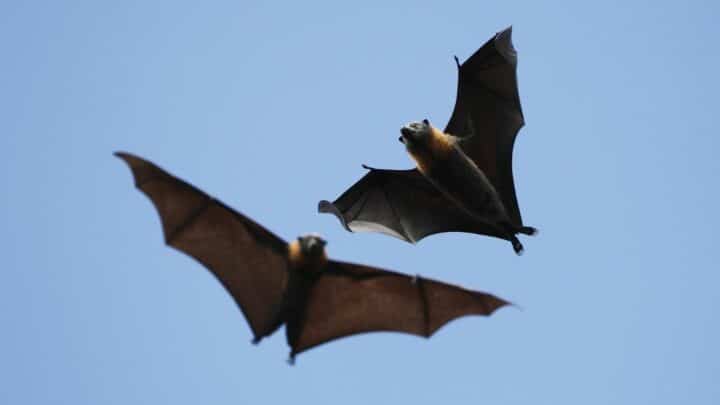Most of us saw bats swishing past as evening falls. These mystical mammals are fascinating to behold and are unique in so many ways.
Apart from their vampire-like appearances and the fact that they sleep upside down, they are also the only mammals on the planet that can fly.
Indeed, it is how they manage to stay airborne that makes them even more interesting.
How do bats fly?
Like humans, bats have five fingers, but between each finger, there is a paper-thin membrane that extends to their chests and backs. When airborne, bats control their flight by spreading out their fingers and propelling themselves through the air. Their immense control over their wings allows them to lift and thrust themselves forward when necessary.
What Bat Wings Look Like
Bat arms are not dissimilar to human arms, and like us, they have forearms and five fingers.
However, unlike us, their fingers are exceptionally lengthy and are joined together, and to their bodies, with exceedingly thin membranes.
Their thumbs, which are their shortest digits, are located at the top tip of their wings and are used for climbing. Some bat breeds also have triangular membranes between their legs and tails, which they may use as a brake.
We generally think of birds when we think of flying animals, but the structure of bird wings and bat wings couldn’t be more different.
Bat wings contain many more bones than bird wings but are substantially less powerful.
However, bats have great control over the movement of their wings than birds do and can fold them in various ways to assist them with multiple maneuvers during flight.
How Bats Use their Wings to Fly
A distinct advantage that bats have is that they are pros at working with gravity. These excellent aviators are famous for the fact that they perch themselves upside down, and interestingly enough, this has everything to do with flying.
They lack the wing power to launch themselves from the ground as birds do, so instead, they drop from their roosting spots straight into flight mode.
Once airborne, bat wings become incredible tools for graceful, swift movement. Working with the air passing over the concave shape of their wings allows them to control the flying process beautifully.
Bats will arch their wings and push downwards with as much force as possible to achieve lift. This thrusting motion works against air pressure and thereby propels them forward.
Alternatively, when bats pull their wings upward, they no longer oppose air force and give themselves a moment to rest. Bats’ lift and thrust flying motions resemble movements similar to rowing or breaststroke.
During the flight, they can dip, swerve, and brake by changing the angles of their fingers. Many bat breeds are even able to hover in midair, like little helicopters.
How Bats Avoid Flying into Things
Bats are not visionless, contrary to what most of us believe. Their tiny eyes are just adapted to see in intense darkness rather than in colorful daylight conditions.
Whereas human eyes comprise both cone and rod photoreceptors, bats have far more rods to use for seeing at night. Sight is one method that they use to avoid flying into things.
In addition to this, their wings contain microscopic receptors call Merkel cells that are sensitive to touch.
They use these receptors (which are covered with even tinier hairs) to detect changes in the air around them and collect information about their environments.
Finally, bats also incorporate a process known as echolocation into their flying protocols. Echolocation is the process whereby bats emit sounds intending to create echoes.
They compare their outgoing noises with their returning echoes to ascertain what is happening in their vicinities.
All of these methods keep bats informed about prey and roosting spots and provide them with the information they need to make complex decisions about their flight paths.
Frequently Asked Questions about How Bats Fly
Why do bats come out at night?
Bats are nocturnal, so they are biologically programmed to snooze in the daytime and hunt when night comes. For them, being active under the veil of darkness has several benefits. Many insects are abuzz in the dark, and bats have an advantage in this regard as the only flying creatures on the hunt. In addition to this, predators that attack bats, like some bird breeds, are easier to avoid at night.
Do bats fly straight?
When we see bats flying at night, their acrobatics and weaving are usually related to the fact that they are hunting. Dipping and swerving are necessary means to an end when you are trying to catch bugs. Occasionally, however, a displaced bat might fly in a straight line to reach a destination, like a roosting spot, in a hurry.
How far and how fast can bats fly?
Using air currents, bats can reach up to 135 km per hour in speed. Some species are known to fly distances of up to 200km.
Conclusion
Bats are brilliant at flying, especially when one considers the delicate composition of their fingers and wings. Yet, it is precisely this highly complex architecture that makes them so good at weaving about in the dark.
A bat can go from arrowing in one direction to pummeling through the sky in another with the flick of a wing.
The next time you see bats near you, treat yourself by paying close attention to the airshow.

